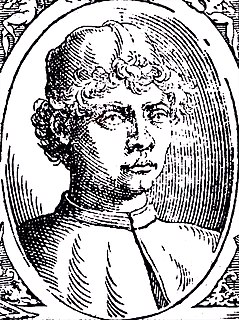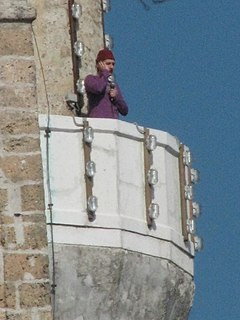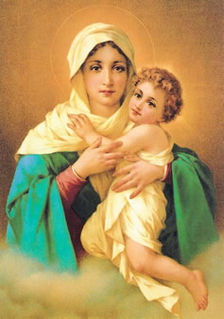
Benedetto Sinigardi, also known as Fra Benedetto di Arezzo or Sinigardi di Arezzo (1190 - 1282) was a Franciscan friar, and is considered to be the author of the Angelus prayer. [1]

Benedetto Sinigardi, also known as Fra Benedetto di Arezzo or Sinigardi di Arezzo (1190 - 1282) was a Franciscan friar, and is considered to be the author of the Angelus prayer. [1]
He was the son of Thomas and Elizabeth Sinigardi a noble and wealthy family.
In 1211, after attending a sermon given by Francis of Assisi in the Piazza Grande in Arezzo he decided to enter the order. In 1217 he was appointed Provincial of the Marches and set off a missionary to Greece, Romania and Turkey. In 1221 he arrived in the Holy Land and stayed there 16 years as Provincial. [2]
He returned to Arezzo and spent his last years in the convent of Poggio del Sole (now demolished) where he died in old age. He was buried in the Basilica of San Francesco, Arezzo.
He is considered the author of the Angelus prayer. This tradition found a surprising and authoritative advocate in Pope John Paul II who, on 23 May 1993, prayed at the tomb of Benedetto before reciting the Angelus. He said, amongst other things We are in the place where, according to tradition, was born the 'custom of reciting the Angelus ...
He is remembered on 13 August each year.
Dionysius Thrax was a Hellenistic grammarian and a pupil of Aristarchus of Samothrace. He was long considered to be the author of the earliest grammatical text on the Greek language, one that was used as a standard manual for perhaps some 1,500 years, and which was until recently regarded as the groundwork of the entire Western grammatical tradition.

Prayer is an invocation or act that seeks to activate a rapport with an object of worship through deliberate communication. In the narrow sense, the term refers to an act of supplication or intercession directed towards a deity, or a deified ancestor. More generally, prayer can also have the purpose of thanksgiving or praise, and in comparative religion is closely associated with more abstract forms of meditation and with charms or spells.

The Holy Rosary, also known as the Dominican Rosary, or simply the Rosary, refers to a set of prayers used in the Catholic Church and to the string of knots or beads used to count the component prayers. When referring to the prayer, the word is usually capitalized ; when referring to the beads, it is written with a lower-case initial letter.

The Hail Mary is a traditional Scripture-based Catholic prayer of praise for and petition to the Blessed Virgin Mary. Since the sixteenth century, the Roman Catholic version of the prayer closes with an appeal for her intercession. Largely based on two phrases in the Gospel of Luke, the prayer takes different forms in various traditions. It has often been set to music.

Piero della Francesca, originally named Piero di Benedetto, was an Italian painter of the Early Renaissance. To contemporaries he was also known as a mathematician and geometer. Nowadays Piero della Francesca is chiefly appreciated for his art. His painting is characterized by its serene humanism, its use of geometric forms and perspective. His most famous work is the cycle of frescoes The History of the True Cross in the church of San Francesco in the Tuscan town of Arezzo.

Benedetto Accolti was an Italian jurist, humanist and historian.

Bernardo Accolti was an Italian poet.

The muezzin is the person who gives the call to prayer at a mosque. The muezzin plays an important role in ensuring an accurate prayer schedule for the Muslim community.

A bell tower is a tower that contains one or more bells, or that is designed to hold bells even if it has none. Such a tower commonly serves as part of a church, and will contain church bells, but there are also many secular bell towers, often part of a municipal building, an educational establishment, or a tower built specifically to house a carillon. Church bell towers often incorporate clocks, and secular towers usually do, as a public service.

The Ardās is a set prayer in Sikhism. It is a part of worship service in a Gurdwara, daily rituals such as the opening the Guru Granth Sahib for prakash or closing it for sukhasan in larger Gurdwaras, closing of congregational worship in smaller Gurdwaras, rites-of-passages such as with the naming of child or the cremation of a loved one, daily prayer by devout Sikhs and any significant Sikh ceremonies.

Memorare is a Catholic prayer seeking the intercession of the Blessed Virgin Mary. Memorare, from the Latin "Remember", is frequently misattributed to the 12th-century Cistercian monk Saint Bernard of Clairvaux, apparently due to confusion with its 17th-century popularizer, Father Claude Bernard, who stated that he learned it from his own father. It first appears as part of a longer 15th-century prayer, "Ad sanctitatis tuae pedes, dulcissima Virgo Maria."

A church bell in the Christian tradition is a bell which is rung in a church for a variety of ceremonial purposes, and can be heard outside the building. Traditionally they are used to call worshippers to the church for a communal service, and to announce the fixed times of daily Christian prayer, called the canonical hours, which number seven and are contained in breviaries. They are also rung on special occasions such as a wedding, or a funeral service. In some religious traditions they are used within the liturgy of the church service to signify to people that a particular part of the service has been reached. The ringing of church bells, in the Christian tradition, is also believed to drive out demons.

The Angelus is a Catholic devotion commemorating the Incarnation. As with many Catholic prayers, the name Angelus is derived from its incipit—the first few words of the text: Angelus Domini nuntiavit Mariæ. The devotion is practised by reciting as versicle and response three Biblical verses narrating the mystery, alternating with the prayer "Hail Mary". The Angelus exemplifies a species of prayers called the "prayer of the devotee".

Japa is the meditative repetition of a mantra or a divine name. It is a practice found in Hinduism, Jainism, Sikhism, Buddhism, and Shintōism.

The Day of Arafah is an Islamic holiday that falls on the 9th day of Dhu al-Hijjah of the lunar Islamic Calendar. It is the holiest day in the Islamic calendar, the second day of the Hajj pilgrimage, and the day after is the first day of the major Islamic holiday of Eid al-Adha. At dawn of this day, Muslim pilgrims will make their way from Mina to a nearby hillside and plain called Mount Arafah and the Plain of Arafah. It was from this site that Muhammad gave one of his last famous sermons in the final year of his life. Some Muslims hold that part of the Quranic verse announcing that the religion of Islam had been perfected was revealed on this day.

The Basilica of San Francesco is a late Medieval church in Arezzo, Tuscany, Italy, dedicated to St Francis of Assisi. It is especially renowned for housing in the chancel the fresco cycle Legends of the True Cross by Piero della Francesca.

Guido Tarlati was a lord and Bishop of Arezzo.

Carlo Marsuppini (1399–1453), also known as Carlo Aretino and Carolus Arretinus, was an Italian Renaissance humanist and chancellor of the Florentine Republic.

The diocese of Cortona was a Roman Catholic ecclesiastical territory in central Italy, which existed from 1325 to 1986. It was immediately subject to the Holy See.

Saint Donatus of Arezzo is the patron saint of Arezzo, and considered a bishop of the city.